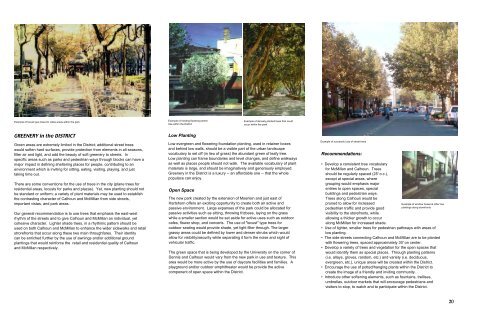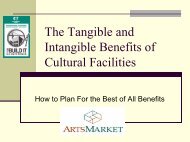CLIFTON HEIGHTS / UC JOINT URBAN RENEWAL PLAN
Clifton Heights / UC Joint Urban Renewal Plan - University of ...
Clifton Heights / UC Joint Urban Renewal Plan - University of ...
- No tags were found...
You also want an ePaper? Increase the reach of your titles
YUMPU automatically turns print PDFs into web optimized ePapers that Google loves.
Example of locust type trees for cafes areas within the parkExample of existing flowering streettree within the DistrictExample of densely planted trees that couldoccur within the parkGREENERY in the DISTRICTGreen areas are extremely limited in the District; additional street treeswould soften hard surfaces, provide protection from elements in all seasons,filter air and light, and add the beauty of soft greenery to streets. Inspecific areas such as parks and pedestrian ways through blocks can have amajor impact in defining sheltering places for people, contributing to anenvironment which is inviting for sitting, eating, visiting, playing, and justtaking time out.There are some conventions for the use of trees in the city (plane trees forresidential areas, locusts for parks and plazas). Yet, new planting should notbe standard or uniform; a variety of plant materials may be used to establishthe contrasting character of Calhoun and McMillan from side streets,important vistas, and park areas.Our general recommendation is to use trees that emphasis the east-westrhythm of the streets and to give Calhoun and McMillan an individual, yetcohesive character. Lighter shade trees, in a rhythmic pattern should beused on both Calhoun and McMillan to enhance the wider sidewalks and retailstrorefronts that occur along these two main throughfares. Their identitycan be enriched further by the use of awnings and/or additional groundplantings that would reinforce the retail and residential quality of Calhounand McMillan respectively.Low PlantingLow evergreen and flowering foundation planting, used in retainer boxesand behind low walls, should be a visible part of the urban landscapevocabulary to set off (in lieu of grass) the abundant green of leafy tree.Low planting can frame boundaries and level changes, and define walkwaysas well as places people should not walk. The available vocabulary of plantmaterials is large, and should be imaginatively and generously employed.Greenery in the District is a luxury -- an affordable one -- that the wholepopulace can enjoy.Open SpaceThe new park created by the extension of Moerlein and just east ofHartshorn offers an exciting opportunity to create both an active andpassive environment. Large expanses of the park could be allocated forpassive activities such as sitting, throwing frizbees, laying on the grasswhile a smaller section would be set aside for active uses such as outdoorcafes, flower shop, and concerts. The use of "locust" type trees foroutdoor seating would provide shade, yet light filter through. The largergrassy areas could be defined by lower and denser shrubs which wouldallow for visibility/security while separating it form the noise and sight ofvehicular traffic.The green space that is being developed by the University on the corner ofDennis and Calhoun would vary from the new park in use and texture. Thisarea would be more active by the use of daycare facilities and families. Aplayground and/or outdoor amphitheater would be provide the activecomponent of open space within the District.Example of successful use of street treesRecommendations:• Develop a consistent tree vocabularyfor McMillan and Calhoun. Treesshould be regularly spaced (25' o.c.),except at special areas, wheregrouping would emphasis majorentries to open spaces, specialbuildings and pedestrian ways.Trees along Calhoun would bepruned to allow for increasedpedestrian traffic and provide goodvisibility to the storefronts, whileallowing a thicker growth to occuralong McMillan for increased shade.Example of window boxes & other lowplantings along storefronts• Use of lighter, smaller trees for pedestrian pathways with areas oflow planting.• The side streets connecting Calhoun and McMillan are to be plantedwith flowering trees, spaced approximately 30' on center.• Develop a variety of trees and vegetation for the open spaces thatwould identify them as special places. Through planting patterns(i.e. allays, groves, random, etc.) and variety (i.e. deciduous,evergreen, etc.), unique areas will be created within the District.• Encourage the use of potted/hanging plants within the District tocreate the image of a friendly and inviting community.• Introduce other softening elements, such as fountains, trellises,umbrellas, outdoor markets that will encourage pedestrians andvisitors to stop, to watch and to participate within the District.20



